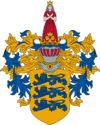Tallin, Foto by Ain Avik

Pocztówka przedstawia miasto Talin stolicę Estonii.
Distance: 1,800 km (1,118 miles)
Travel time: 5 days

Pocztówka przedstawia miasto Talin stolicę Estonii.
 |
| Herb Tallinna |
Tallinn (est. Tallinn, od 1219 do 1918 Rewel est. Reval, także Lindanäs, Lyndanise, Kalevanlinna oraz Koływań) – stolica Estonii i port nad Morzem Bałtyckim (na południowym brzegu Zatoki Fińskiej).
W Tallinnie, mimo licznych zniszczeń z okresu II wojny światowej, skrupulatnie odbudowano średniowieczne obwarowania miejskie z basztami i bramami – baszty Megede i Kiek in de Kök (XIV-XV wiek), basztę Paks Margareeta (Gruba Małgorzata, XVI wiek), Bramę Morską (XVI w.).
Na brzegu zatoki, na wprost odległego o kilometr Pałacu Kadriorg stoi pomnik upamiętniający 177 rosyjskich marynarzy, którzy zatonęli w 1893 wraz ze swoim okrętem wojennym "Rusałka".
Tallińskie stare miasto zostało w 1997 wpisane na listę światowego kulturowego dziedzictwa ludzkości UNESCO (w tym samym roku wpisano na tę listę zespół zabudowy staromiejskiej Torunia). W 2002 r. odbył się w Tallinnie Konkurs Piosenki Eurowizji.
Tallinn is the capital and largest city of Estonia. It occupies an area of 159.2 km2 (61.5 sq mi) with a population of 411,196.
It is situated on the northern coast of the country, on the banks of the Gulf of Finland, 80 km (50 mi) south of Helsinki, west of Saint Petersburg.
The origin of the name "Tallinn(a)" is certain to be Estonian, although the original meaning of the name is debated. It is usually thought to be derived from "Taani-linn(a)" (meaning "Danish-castle/town"; Latin: Castrum Danorum) after the Danes built the castle in place of the Estonian stronghold at Lindanisse. However, it could also have come from "tali-linna" ("winter-castle/town"), or "talu-linna" ("house/farmstead-castle/town"). The element -linna, like Germanic -burg and Slavic -grad / -gorod, originally meant "fortress" but is used as a suffix in the formation of town names.
The previously used official German name Reval (help·info) (Russian: Ревель) was replaced after Estonia became independent in 1918–1920. At first both forms Tallinna and Tallinn were used. The United States Board on Geographic Names adopted the form Tallinn between June 1923 and June 1927. The form Tallinna appearing in modern times in Estonian denotes the genitive case of the name, as in Tallinna Reisisadam (Port of Tallinn).
Other variations of modern spellings include Tallinna in Finnish and Та́ллин in Russian.
A form Tallin deriving from the Romanization of Russian spelling of the name Та́ллин was also used internationally during the era Estonia was annexed by the Soviet Union.
Distance: 1,800 km (1,118 miles)
Travel time: 5 days


No comments:
Post a Comment